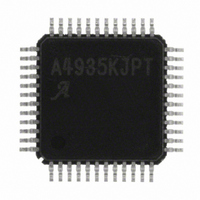A4935KJPTR-T Allegro Microsystems Inc, A4935KJPTR-T Datasheet - Page 12

A4935KJPTR-T
Manufacturer Part Number
A4935KJPTR-T
Description
AUTO THREE-PHASE MOSFET PREDRIVER
Manufacturer
Allegro Microsystems Inc
Datasheet
1.A4935KJPTR-T.pdf
(24 pages)
Specifications of A4935KJPTR-T
Configuration
3 Phase Bridge
Input Type
PWM
Delay Time
90ns
Number Of Configurations
1
Number Of Outputs
3
Voltage - Supply
5.5 V ~ 50 V
Operating Temperature
-40°C ~ 150°C
Mounting Type
Surface Mount
Package / Case
48-LFQFP Exposed Pad
Operating Temperature Classification
Automotive
Operating Supply Voltage (min)
3V
Operating Supply Voltage (max)
5.5V
Lead Free Status / RoHS Status
Lead free / RoHS Compliant
Current - Peak
-
High Side Voltage - Max (bootstrap)
-
Lead Free Status / Rohs Status
Compliant
Other names
620-1300-2
A4935KJPTR-T
A4935KJPTR-T
Available stocks
Company
Part Number
Manufacturer
Quantity
Price
Company:
Part Number:
A4935KJPTR-T
Manufacturer:
Allegro Microsystems Inc
Quantity:
135
Company:
Part Number:
A4935KJPTR-T
Manufacturer:
Allegro MicroSystems, LLC
Quantity:
10 000
Part Number:
A4935KJPTR-T
Manufacturer:
ALLEGRO/雅丽高
Quantity:
20 000
A4935
switching. Any short faults detected will always be latched in the
fault register.
When a short or undervoltage fault is present, a clock can be
applied to FF2 and detailed fault information can be read from
FF1 as a serial word. This can be used to determine on which of
the six external FETs a short is being detected, or which of the
monitored voltages have gone below their undervoltage threshold
level. Fault register serial access operation is detailed in the Fault
Register Serial Access section.
Fault States
Overtemperature
temperature threshold, typically 165°C, the A4935 will enter the
overtemperature fault state and FF1 will go high. The overtem-
perature fault state, and FF1, will only be cleared when the tem-
perature drops below the recovery level defined by T
Note that an overtemperature fault does not permit access to the
fault register because FF2 is pulled low.
If ESF is set high when an overtemperature is detected, the out-
puts will be disabled automatically while the fault state is present.
If ESF is set low, then no circuitry will be disabled. In this case
external control circuits must take action to limit the power dis-
sipation in some way so as to prevent overtemperature damage to
the chip and unpredictable device operation.
VREG Undervoltage
and the bootstrap charge current. It is critical to ensure that the
voltages are sufficiently high before enabling any of the outputs.
If the voltage at VREG, V
undervoltage lockout threshold, V
enter the VREG undervoltage fault state. In this fault state, both
FF1 and FF2 will be high, and the outputs will be disabled. The
VREG undervoltage fault state and the fault flags will be cleared
when V
threshold, V
The VREG undervoltage monitor circuit is active during pow-
er-up, and the A4935 remains in the VREG undervoltage fault
state until V
lockout threshold, V
REG
rises above the rising VREG undervoltage lockout
REG
REGUVon
is greater than the rising VREG undervoltage
If the junction temperature exceeds the over-
.
REGUVon
VREG supplies the low-side gate driver
REG
.
, drops below the falling VREG
REGUVoff
, then the A4935 will
JF
– T
Automotive 3-Phase MOSFET Driver
JFhys
.
Any time the A4935 enters the VREG undervoltage fault state,
bit 7 in the fault register will be set and will remain set until cleared
by a register reset (see the Fault Register Serial Access section).
Bootstrap Capacitor Undervoltage
voltage across the individual bootstrap capacitors to ensure they
have sufficient charge to supply the current pulse for the high-
side drive. Before a high-side drive can be turned on, the voltage
across the associated bootstrap capacitor must be higher than the
turn-on voltage limit. If this is not the case, then the A4935 will
start a bootstrap charge cycle by activating the complementary
low-side drive. Under normal circumstances, this will charge the
bootstrap capacitor above the turn-on voltage in a few microsec-
onds and the high-side drive will then be enabled.
The bootstrap voltage monitor remains active while the high-side
drive is active and if the voltage drops below the turn-off voltage
a charge cycle is initiated.
In either case, if there is a fault that prevents the bootstrap capaci-
tor charging, then the charge cycle will timeout, the fault flags
(indicating an undervoltage) will be set, and the outputs will be
disabled. In addition, the appropriate bit in the fault register will
be set. This allows the specific phase giving the bootstrap under-
voltage to be determined by reading the serial data word.
The bootstrap undervoltage fault state remains latched until
RESET is set low or a serial read of the fault register is com-
pleted.
VDD Undervoltage
tored to ensure correct logical operation. If an undervoltage
on VDD is detected, the outputs will be disabled. In addition,
because the state of other reported faults cannot be guaranteed,
all fault states, fault flags, and the fault register are reset and
replaced by the fault flags corresponding to a VDD undervoltage
fault state. For example, a VDD undervoltage will reset an exist-
ing short circuit fault condition and replace it with a VDD under-
voltage fault. When the VDD undervoltage condition is removed,
all flags will be cleared and the outputs enabled.
Short Fault Operation
by monitoring the drain-souce voltage, V
and comparing it to the fault threshold voltage at the VDSTH pin.
Because power MOSFETs take a finite time to reach the rated on-
resistance, the measured drain-source voltages will show a fault
as the phase switches. To avoid such false short fault detections,
The logic supply voltage at VDD is moni-
Shorts in the power bridge are determined
115 Northeast Cutoff
1.508.853.5000; www.allegromicro.com
Allegro MicroSystems, Inc.
Worcester, Massachusetts 01615-0036 U.S.A.
The A4935 monitors the
DS
, of each active FET
12
















